Key takeaways:
- Understanding gender equality advocacy involves recognizing systemic barriers and the power of personal storytelling to shift perspectives and inspire change.
- Policy change is essential for lasting transformation, as it not only influences societal norms but also holds organizations accountable for equality.
- Effective campaigns utilize clear messaging, storytelling, and strategic partnerships to engage communities and drive advocacy efforts.
- Grassroots mobilization is strengthened by social media engagement, coalition-building, and resource-sharing among advocacy groups.

Understanding gender equality advocacy
Understanding gender equality advocacy means recognizing the systemic barriers that hinder equal opportunities for all genders. In my experience, I’ve seen how cultural norms can shape perceptions and behaviors, often leading to discrimination. Have you ever wondered how a single conversation can shift someone’s understanding of gender roles? I’ve witnessed moments when someone, upon hearing a personal story, has had their perspective fundamentally changed.
As I reflect on my journey in this field, I realize that gender equality advocacy is both a mission and a personal calling. I remember a campaign I helped organize where we shared real stories of individuals affected by gender disparities. Those stories resonated deeply with the audience, sparking empathy and igniting discussions that had been long overdue. It’s fascinating how the human connection can drive the push for policy changes and break down the walls of indifference.
Furthermore, effective gender equality advocacy requires a blend of passion and strategy; it’s about knowing when to listen and when to speak. In one instance, I found myself in a heated debate about pay equity, and it struck me how essential it is to approach these discussions with a blend of facts and personal impact. Isn’t it powerful to think that change often starts with a single voice calling for justice? Each one of us, in our capacity, can contribute to this ongoing dialogue that pushes society towards fairness.
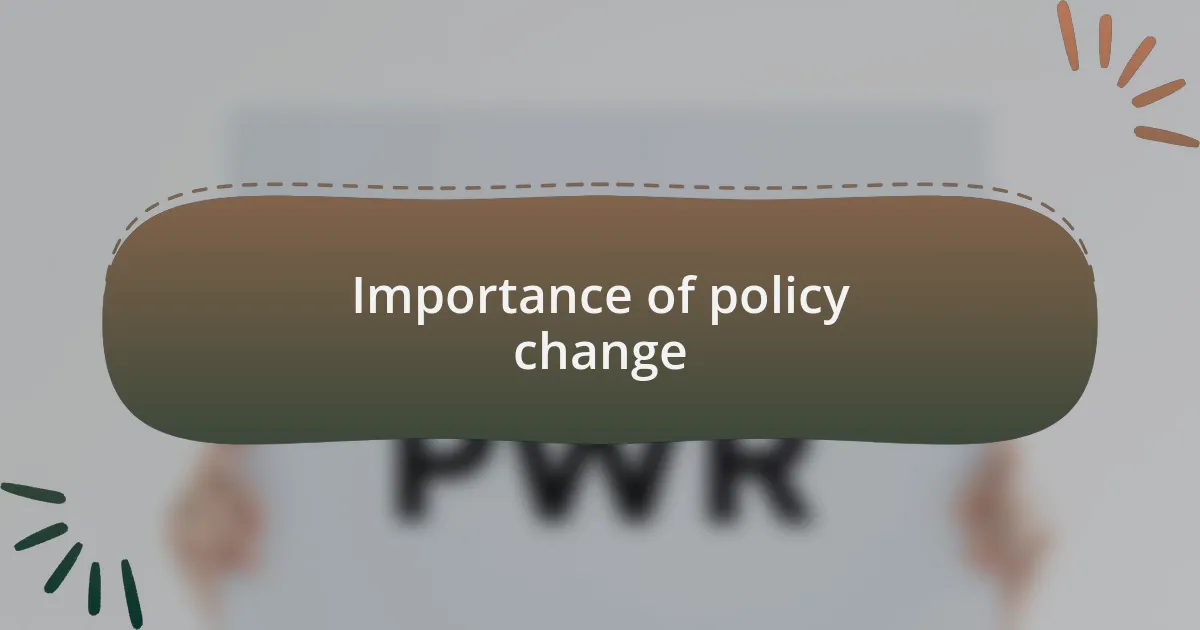
Importance of policy change
Policy change is vital in the fight for gender equality because it lays the groundwork for lasting transformation. I recall a local initiative where we pushed for legislative reforms to protect against workplace discrimination. Watching that policy evolve was a powerful reminder that systemic change often starts with individuals like us who dare to challenge the status quo.
When laws reflect the values of equity and justice, they have the power to influence societal norms. I once attended a community meeting where individuals shared how their lives improved after new policies were enacted to support parental leave. Their stories made me appreciate that policy change doesn’t just alter legislation but also profoundly impacts people’s day-to-day realities. Have you ever experienced a change in the law that directly affected your life? It’s remarkable how these shifts can empower and uplift communities, sparking conversations that lead to more inclusive environments.
Moreover, policy change creates accountability, which is crucial for sustaining progress in gender equality. During an advocacy project, I saw how implementing strict guidelines on equal pay motivated organizations to take action. This experience taught me that when policies are in place, they encourage not just compliance but a cultural shift where equality becomes the norm rather than the exception. How can we afford to overlook the ripple effect of these changes in our pursuit of justice? The importance of policy change cannot be overstated; it is the backbone of meaningful, transformative progress.
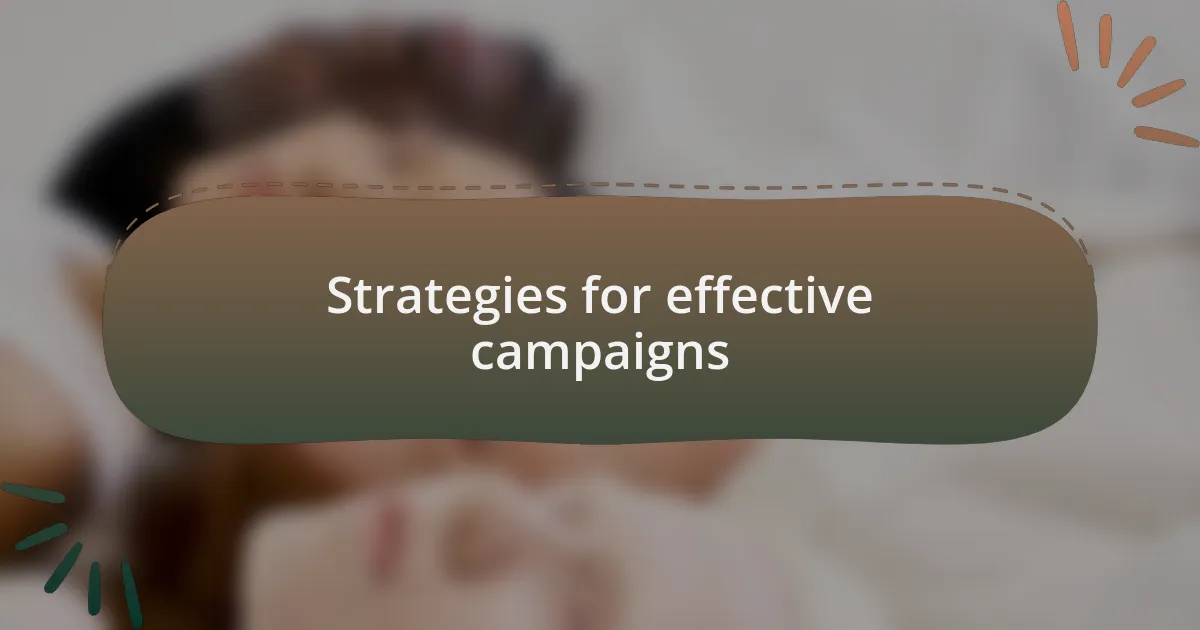
Strategies for effective campaigns
When it comes to executing effective campaigns, clarity in messaging is paramount. I remember a particular campaign focused on combating gender-based violence, where we honed in on clear, concise slogans that resonated deeply with our audience. Every time I saw someone wearing our campaign T-shirt with a powerful statement, it reinforced how effective communication can galvanize support and raise awareness.
Engaging storytelling can also be a game changer in advocacy efforts. During one campaign, we shared weekly stories from survivors, each uniquely illustrating the pressing need for policy change. Those intimate, heartfelt narratives created a sense of urgency and connection that mere statistics could never achieve. Have you ever felt moved by someone’s story? It’s that emotional engagement that often spurs action more than any data point could.
Leveraging partnerships with local influencers or organizations can amplify the reach of your campaign significantly. In my experience, collaborating with a popular community leader not only helped us tap into their established audience but also lent credibility to our cause. It made me realize that sometimes, a single endorsement or voice can unlock doors and create opportunities that we, as advocates, might not have accessed alone. Isn’t it fascinating how connection can foster change in ways we might not initially foresee?
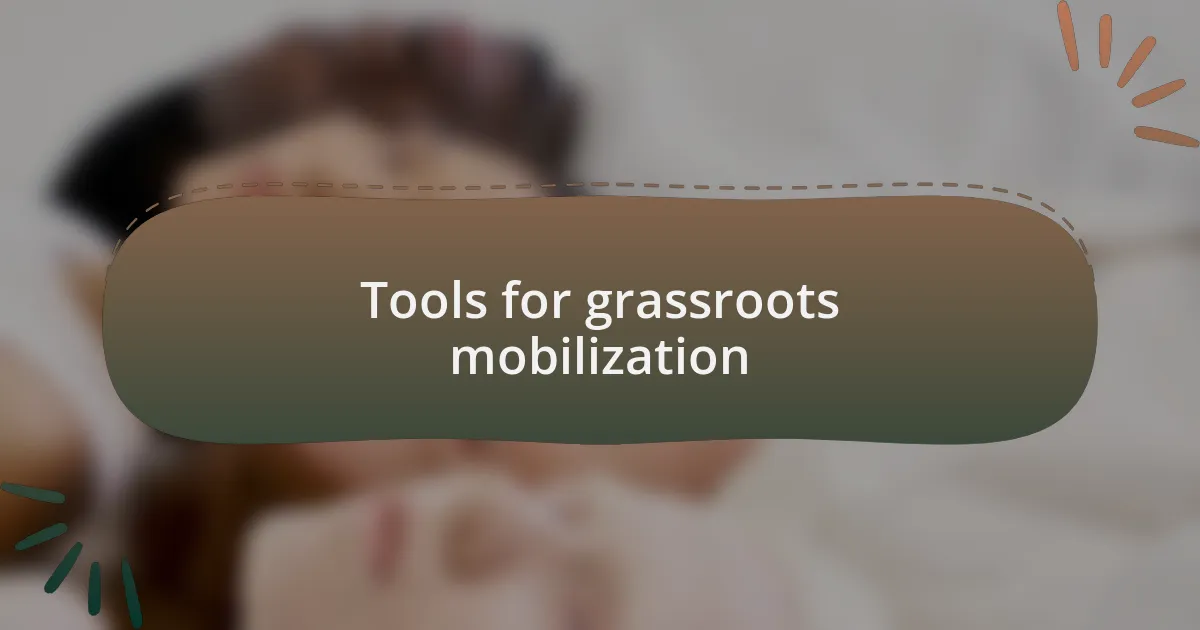
Tools for grassroots mobilization
Mobilizing grassroots movements requires a toolkit of effective strategies, and social media stands out as one of the most powerful tools. I recall organizing a local rally where we used platforms like Twitter and Instagram to create buzz and invite participants. The real-time interaction not only drew in a crowd but also fostered a sense of community among supporters who shared our posts and engaged with our content. Have you ever seen a post go viral? It’s exhilarating to witness your ideas reaching far beyond your immediate circle.
Another vital resource for grassroots mobilization is building a strong coalition of supporters. During a campaign I was part of, we hosted regular meet-ups to brainstorm ideas and share experiences. This safe space for dialogue transformed casual supporters into passionate advocates. It made me realize that people often crave connection and a sense of belonging in a cause. Do you think this shared commitment can truly spark change? I’ve seen it happen firsthand, as these connections often lead to more collaborative and impactful initiatives.
Finally, grassroots mobilization can greatly benefit from the art of resource-sharing. I remember a time when we pooled materials—like flyers and informational pamphlets—across different advocacy groups. This collaboration not only cut costs but also ensured that our messaging remained consistent and powerful. Isn’t it interesting how sharing resources can amplify our voices? I’ve found that when we work together, we can reach further and make a more significant impact than we ever could alone.
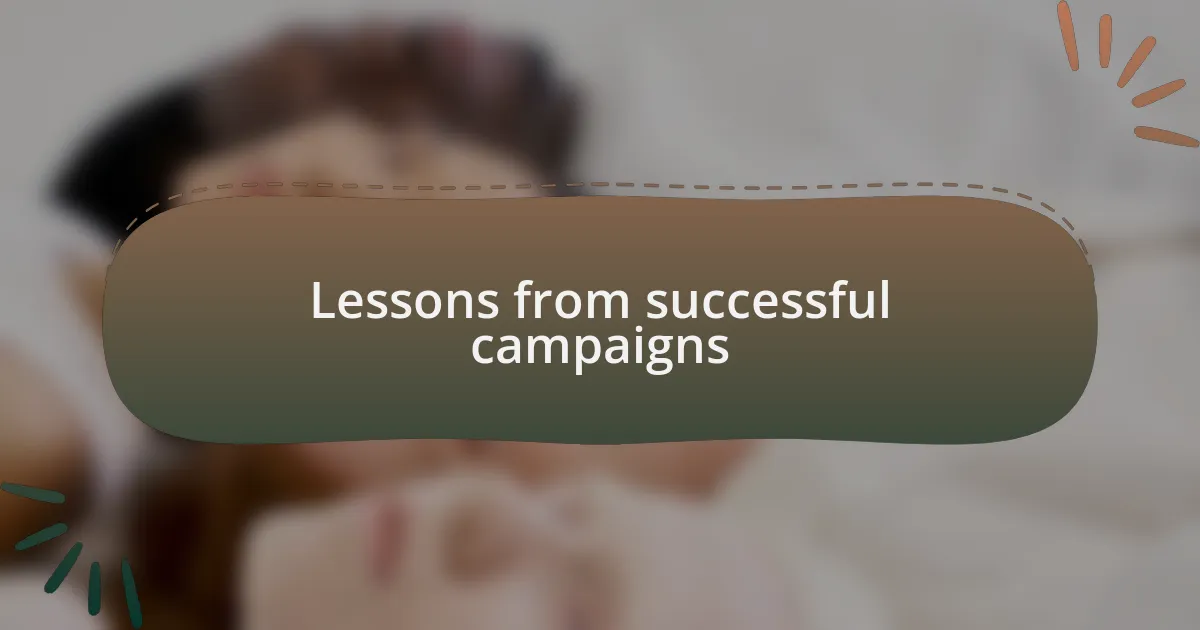
Lessons from successful campaigns
Successful campaigns often share a crucial lesson: the power of storytelling. I remember attending a workshop where participants shared their personal experiences related to gender inequality. These heartfelt stories made abstract statistics come alive, capturing the audience’s attention and empathy. Have you felt that moment when a story resonates deeply with you? It’s that emotional connection that spurs people into action, proving that our narratives can be a potent tool in advocacy.
Another important takeaway is the significance of adaptability in campaign strategies. I once worked on a campaign that faced unexpected backlash due to misunderstandings about our message. Rather than sticking rigidly to our original plan, we pivoted quickly, listening to concerns and making adjustments. This experience taught me that being responsive not only builds trust, but it also strengthens our position. Isn’t it fascinating how flexibility can turn potential setbacks into opportunities for growth?
Lastly, successful campaigns highlight the importance of celebrating small victories. During a campaign I led, we would take time to acknowledge even minor milestones. For instance, when we reached a specific number of petition signatures, we gathered our supporters to celebrate and share the joy. These moments fostered motivation and strengthened our resolve. I often wonder, how can we overlook these small wins in a quest for bigger changes? They remind us that progress, no matter how incremental, is still advancement in our fight for equity.
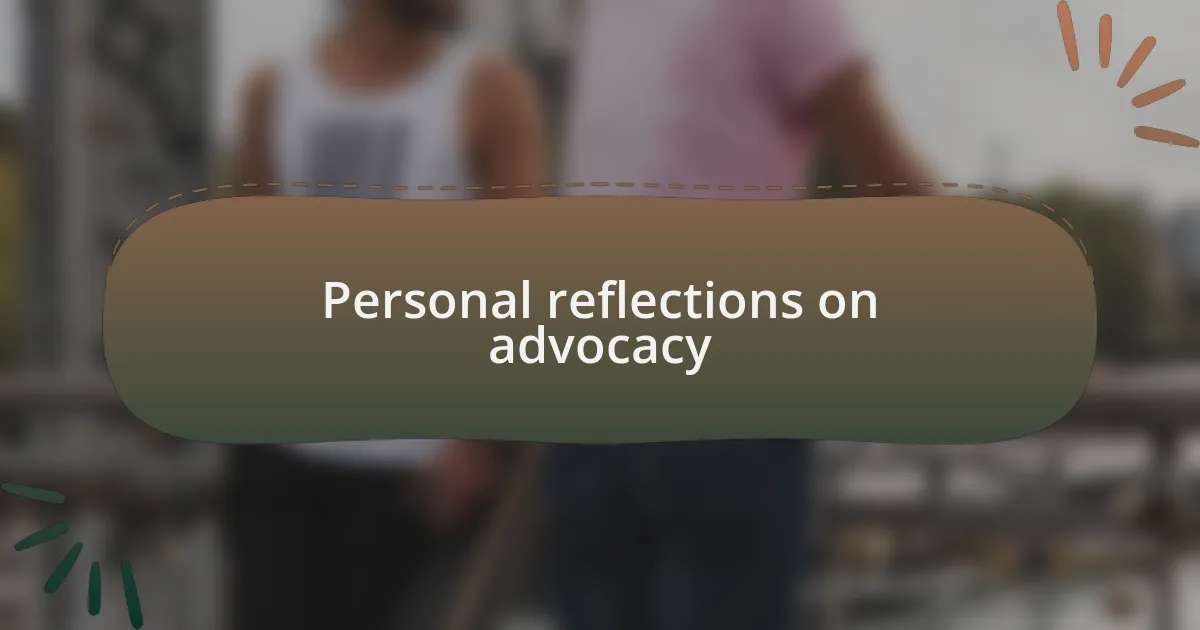
Personal reflections on advocacy
Personal advocacy has been a journey of self-discovery for me. I vividly recall my first significant act of advocacy, which was a local event focused on women’s rights. Standing up to speak about the challenges I faced felt daunting yet empowering. That mix of fear and determination taught me that our voices can hold immense power, even when we feel small. Have you ever felt that rush of adrenaline when you stand up for something you believe in?
Another reflection centers around community engagement. I once volunteered for a coalition that aimed to amplify marginalized voices. It was incredible to witness how sharing the spotlight can transform a narrative. Listening to others helped me realize that advocacy isn’t just about amplifying my own voice; it’s about creating a platform for others. Isn’t it incredible how collaboration can enhance the impact of our efforts?
Moreover, I’ve learned that self-care remains crucial amidst the challenges of advocacy. I used to forget this, diving headfirst into campaigns without pause. There was a time when the emotional weight overwhelmed me, and I learned the hard way that taking care of oneself is not selfish; it’s essential. How often do we remember to recharge ourselves in the pursuit of a larger goal? Prioritizing my well-being allowed me to return with renewed energy and commitment, making me a more effective advocate in the long run.
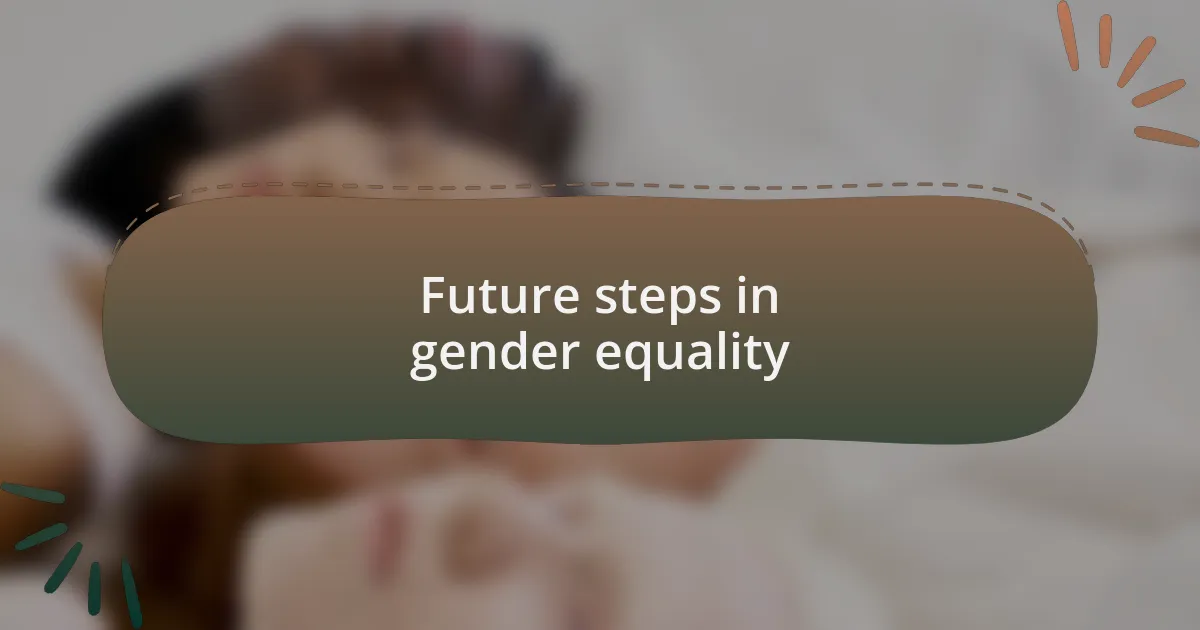
Future steps in gender equality
The road ahead for gender equality demands a multi-faceted approach that goes beyond policy change. Last year, while attending a summit on gender issues, I realized that grassroots movements are pivotal in propelling this agenda forward. Seeing passionate individuals share their stories reinforced my belief that real change often starts with local communities, making their collective experiences essential catalysts for broader societal transformation.
As I reflect on future steps, I recognize the importance of education in empowering future generations. During a recent mentorship session with young women, I was struck by their eagerness to learn and challenge norms. It’s discernible that equipping youth with knowledge about gender rights can create a ripple effect, fostering advocates who continue the fight long after we’re gone. How can we ensure that the lessons learned today are preserved for tomorrow’s leaders?
Furthermore, advocating for policy changes requires that we stay adaptable and responsive to new challenges. I recall a discussion where we brainstormed innovative approaches to counter emerging threats to women’s rights. The necessity for resilience became apparent; policies must evolve as society changes. Isn’t it fascinating how the landscape of gender equality can shift so quickly, demanding that we stay engaged and proactive? This adaptability could be the key to sustaining our progress in this vital fight.